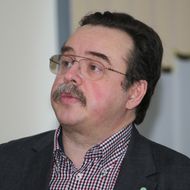Researchers Explain Potential Cause of Earth’s Green Airglow

A team of Russian researchers from HSE University, the Russian Space Research Institute, and the Pushkov Institute of Terrestrial Magnetism (Russian Academy of Sciences) has described the development of modulational instability of electromagnetic waves in dusty ionospheric plasma, which is caused by a high intensity of electromagnetic emissions. The researchers considered inelastic collisions of ionospheric plasma particles and formulated new tasks and applications to be addressed at a later stage. The results are published in the Physics of Plasmas journal.
Modulational interaction is an important factor in explaining various natural phenomena. It is a key process observed when plasma transitions from weak turbulence to strong turbulence. In weak turbulence, plasma waves are chaotic, but only weakly correlate with one another. Strong turbulence produces a stronger correlation, which results in the formation of strongly correlated structures (solitons, cavitons, filaments), the generation of magnetic fields, and the warming and effective acceleration of particles.
In a previous study from 2009, the researchers looked into the possibility of modulational instability developing in ionospheric plasma at altitudes of 80–120 km during high-speed meteor showers. These meteor showers appear to cause the formation of dusty plasma at such altitudes, which in turn significantly affects the character of non-linear plasma processes.
The new research highlights the important role played by inelastic collisions between neutrals (neutral ions) and electrons and ions of the dusty ionospheric plasma. The effect of modulational instability on the propagation of electromagnetic waves in dusty ionospheric plasma is most significant at 100–120 km. This is the altitude of dense atmospheric layers in which spacecraft heat up. When entering these altitudes, meteoroids evaporate, after which meteor matter condenses and small particles form to become part of dusty plasma.
Modulational instability in dusty plasma affects the low frequency area of the electromagnetic noise spectrum and generates infrasonic waves which may reach Earth’s surface.

Professor Sergey Popel, author of the article, Professor of the HSE Faculty of Physics, and Head of Laboratory of Dusty Plasma Processes in Space Objects of the Space Research Institute of the Russian Academy of Sciences
Infrasonic waves may be excited by volcanic eruptions, earthquakes, supersonic planes, explosions on the ground, etc. It is essential to identify infrasonic sources in order to understand the origin of infrasound.
Modulational interaction at altitudes of 110–120 km helps to explain the amplification of green radiation density in the sky at the 557.7 nm wavelength. It generates dusty sonic waves which become unstable at altitudes higher than 110 km, thus causing vortexes. These vortexes move matter at different altitudes, creating conditions for chemical reactions accompanied by photon emissions. We see the photons as green airglow.
Modulational interaction also creates heterogeneous electron and ion concentrations in the ionosphere when powerful heating facilities such as HAARP, EISCAT, etc are in operation.
The authors of the article also studied dusty plasma in meteor tails. The research shows that modulational interaction can also explain observed effects such as the electrophonic noise of meteors in flight.
‘Our results are important, as they can explain and describe natural phenomena in Earth’s ionosphere and atmosphere—in particular, the propagation of electromagnetic waves at altitudes of 90 to 120 km. We are planning to continue our research into the effect of heterogeneity in modulational excitation in the ionosphere caused by facilities such as HAARP, EISCAT, etc, which affect Earth’s atmosphere,’ says Sergey Popel.
See also:
Scientists at HSE University Devise More Accurate Method for Predicting the Electrical Conductivity of Electrolyte Solutions
Researchers at HSE MIEM have developed a model for calculating the electrical conductivity of aqueous electrolyte solutions; for the first time, it considers the spatial distribution of ion charges instead of assuming their localisation at a single point. The model remains effective even at high electrolyte concentrations and across a wide temperature range. This breakthrough will contribute to the development of more efficient batteries and enable the calculation of electrical conductivity without the need for experimental testing. The study has been published in the Journal of Chemical Physics.
Russian Scientists Integrate Microdisk Laser and Waveguide on a Single Substrate
A group of Russian scientists led by Professor Natalia Kryzhanovskaya at HSE Campus in St Petersburg has been researching microdisk lasers with an active region based on arsenide quantum dots. For the first time, researchers have successfully developed a microdisk laser coupled with an optical waveguide and a photodetector on a single substrate. This design enables the implementation of a basic photonic circuit on the same substrate as the radiation source (microlaser). In the future, this will help speed up data transfer and reduce equipment weight without compromising quality. The study results have been published in Semiconductors.
HSE, University of Delhi, and Geoscan Launch Space Research Project
HSE University and the University of Delhi (India), in partnership with Geoscan (a portfolio company of the Innopraktika non-state development institute), have agreed to establish an international scientific mirror laboratory on data storage, processing, and transmission in space systems. The agreement was signed on January 15, 2025, during a visit to India by an HSE University delegation led by Rector Nikita Anisimov.
First Successful Attempt in 55 years: Physicists in Russia and Germany Confirm 1969 Experiment Results
A team of researchers, with the participation of physicists from HSE University, replicated the 1969 experiment on superconductivity and its properties. The scientists induced superconductivity by deliberately deteriorating the interfaces between the layers of superconductors and ferromagnets in the system, resulting in better performance of spin valves compared to the classical version, where the interfaces between the layers are ideal. This approach could lead to the development of more efficient devices for data storage and computing. The study findings have been published in the Beilstein Journal of Nanotechnology.
Russian Physicists Determine Indices Enabling Prediction of Laser Behaviour
Russian scientists, including researchers at HSE University, examined the features of fibre laser generation and identified universal critical indices for calculating their characteristics and operating regimes. The study findings will help predict and optimise laser parameters for high-speed communication systems, spectroscopy, and other areas of optical technology. The paper has been published in Optics & Laser Technology.
HSE Scientists Have Developed a New Model of Electric Double Layer
This new model accounts for a wide range of ion-electrode interactions and predicts a device's ability to store electric charge. The model's theoretical predictions align with the experimental results. Data on the behaviour of the electric double layer (EDL) can aid in the development of more efficient supercapacitors for portable electronics and electric vehicles. The study has been published in ChemPhysChem.
HSE Scientist Optimises Solution of Hydrodynamics Problems
Roman Gaydukov, Associate Professor at the MIEM HSE School of Applied Mathematics, has modelled the fluid flow around a rotating disk with small surface irregularities. His solution allows for predicting fluid flow behaviour without the need for powerful supercomputers. The results have been published in Russian Journal of Mathematical Physics.
Physicists from Russia and Brazil Unveil Mystery behind Complex Superconductor Patterns
Scientists at HSE MIEM and MIPT have demonstrated that highly complex spatial structures, similar to the intricate patterns found in nature, can emerge in superconductors. Mathematically, these patterns are described using the Ginzburg–Landau equation at a specific combination of parameters known as the Bogomolny point. The paper has been published in the Journal of Physics: Condensed Matter.
Adhesive Tape Helps Create Innovative THz Photodetector
An international team of researchers, including scientists at HSE University and Moscow Pedagogical State University (MPGU), has developed a novel photodetector composed of a thin superconducting film, capable of detecting weak terahertz (THz) radiation. This discovery holds promise for studying objects in space, developing wireless broadband communication systems, and making advancements in spectroscopy. The study has been published in Nano Letters.
Operation of Cellular Networks Found Similar to Bacteria Growth in Petri Dish
Scientists at the HSE Laboratory for Computational Physics have developed a new model for analysing communication networks that can significantly enhance the speed of mobile communications. To achieve this, the researchers used computational physics methods and phase transition models. It turns out that the functioning of cellular networks is in many ways similar to the growth of surfaces in physics. The study was performed using the HPC cHARISMa cluster at HSE University. The study findings have been published in Frontiers in Physics.


